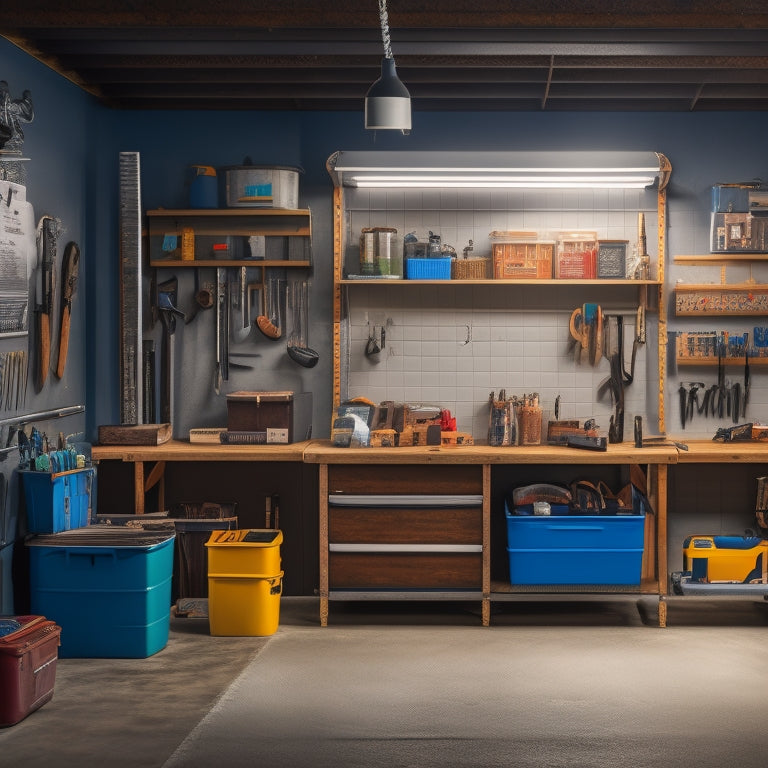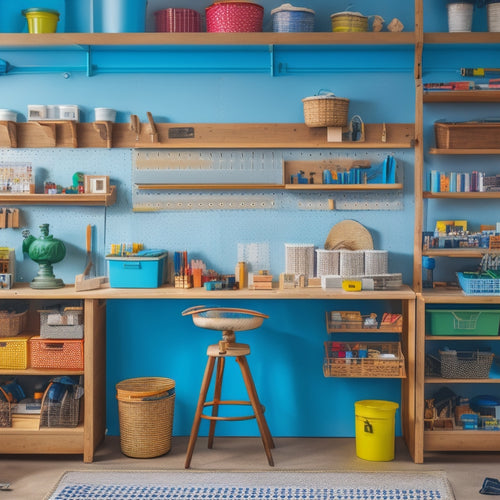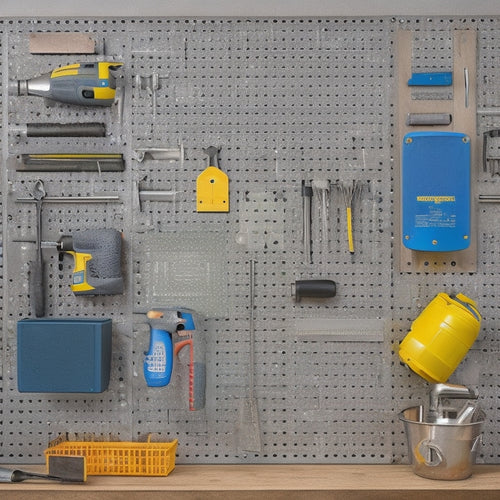
Garage Tool Organization Systems to Boost Productivity
Share
You can optimize your garage's productivity by implementing a well-planned tool organization system that streamlines your workflow, reduces downtime, and enhances overall efficiency. Select the right toolbox type, use storage bins for small parts, and position frequently used tools in accessible locations. Employ cabinets, pegboards, and custom shelving to maximize storage capacity. Integrate sliding racks, pegboard hooks, and mobile carts to create versatile storage options. By maximizing vertical space, labeling tools, and categorizing storage areas, you'll reduce clutter and increase productivity. Now, investigate specific solutions customized to your unique needs, and uncover how to take your garage's efficiency to the next level.
Key Takeaways
- Implement tool storage systems, like portable chests and pegboards, to reduce downtime and enhance efficiency.
- Maximize vertical space with wall-mounted shelves, ceiling storage, and tiered organizers to free up floor area.
- Designate specific workbench areas for different tasks, maintaining a clean surface and positioning frequently used tools at comfortable heights.
- Utilize clear and concise labeling on shelves or bins to indicate tool types, reducing time spent searching for tools.
- Create distinct zones for specific tasks, such as workstation, storage, and project zones, to enhance workflow efficiency and reduce clutter.
Tool Storage Systems for Efficiency
Get a grip on your toolbox chaos by implementing tool storage systems that enhance efficiency. You'll be able to quickly locate the right tool for the job, reducing downtime and increasing productivity.
Start by selecting the right toolbox type for your needs, such as a portable chest, rolling cabinet, or pegboard. Once you've got your toolbox, it's time to organize the contents.
Storage bins are a great way to keep small parts and accessories tidy. Label each bin so you can easily identify what's inside. Consider using dividers or compartments to separate larger tools, like wrenches and pliers, from smaller items.
By keeping frequently used tools in easy-to-reach locations, you'll save time and effort. Additionally, storing heavy tools near the floor will reduce the risk of accidents and injuries.
With a well-designed tool storage system, you'll be able to focus on getting the job done rather than searching for the right tool.
Maximizing Vertical Space
By optimizing your toolbox's layout, you've already taken a significant step towards streamlining your work process.
Now, it's time to maximize your garage's vertical space to further enhance productivity.
Install wall-mounted shelves, vertical racks, and hanging bins to store less frequently used tools and equipment. This will keep them out of the way but still easily accessible.
Tiered organizers and ceiling storage can also be used to store items like seasonal decorations or infrequently used machinery.
Magnetic strips can be attached to walls or tool carts to hold small metal items like wrenches and pliers.
Pegboard hooks can be used to hang items like bikes, helmets, or extension cords.
Consider ladder storage solutions to keep ladders off the floor and out of the way.
Tool carts with built-in storage can be placed near workstations to keep essential tools within easy reach.
Workbench Organization Essentials
Organizing your workbench is crucial to enhancing productivity and reducing frustration. A cluttered workbench can lead to accidents, wasted time, and decreased morale.
To maximize your workspace, start by designating specific areas for different tasks. This will help you stay focused and avoid mixing tools and materials.
Install workbench accessories, such as vice mounts, tool holders, and drawers, to keep frequently used items within easy reach. Verify your workspace ergonomics are on point by positioning your most-used tools at a comfortable height, reducing strain on your back and shoulders. This will help you maintain a safe and healthy working environment.
Keep your work surface clean and clear of debris. Establish a routine of cleaning up as you go to prevent clutter from building up.
Pegboard Installation Tips
You've optimized your workbench with designated task areas, ergonomic tool placement, and a clean work surface. Now, it's time to maximize your wall space with a pegboard installation that streamlines your tool organization. To get started, choose a location that's easily accessible and within reach of your workbench.
Pegboard Installation Considerations
| Pegboard Feature | Installation Tip | Safety Benefit |
|---|---|---|
| Hooks | Install at a comfortable height to avoid straining | Reduces risk of back injury |
| Bins | Label and organize by tool type or frequency of use | Prevents tool mix-ups and saves time |
| Accessories | Choose pegboard accessories that fit your tool set | Guarantees proper storage and reduces clutter |
When selecting pegboard accessories, consider the types of tools you need to store. Wall-mounted tools like hammers, screwdrivers, and pliers can be hung from hooks, while smaller items like nuts and bolts can be stored in bins. By following these installation tips, you'll create a pegboard system that enhances your productivity and keeps your workspace safe and organized.
Customized Cabinet Solutions
Two-thirds of your garage's storage capacity lies within its cabinets. Customized cabinet solutions can help you maximize this space and create a more efficient workshop.
Consider installing custom shelving and modular cabinets that cater to your specific toolset and needs. Drawer dividers can help you separate and organize small items, while a tool chest can provide a dedicated space for your most frequently used tools.
Sliding racks and pegboard hooks can be integrated into your cabinet design to add versatility and accessibility. Workbench cabinets can provide additional storage for supplies and materials, keeping them out of the way but still within reach.
Mobile carts can be used to transport tools and equipment around the garage, reducing clutter and increasing productivity. Wall-mounted storage bins and cabinets can help keep the floor clear and provide additional storage for less frequently used items.
Labeling and Signage Strategies
You'll maximize your garage tool organization system's efficiency by implementing clear labeling and signage strategies.
Start by categorizing your tools and labeling them accordingly, ensuring you can quickly identify where each item belongs.
Next, consider color-coding your signage to visually distinguish between different storage areas, making it easy to visualize your storage layout.
Labeling Tool Categories
Organize your tools by categorizing them into groups, and then assign a clear label to each category. This approach allows you to quickly identify where each tool belongs, making it easier to find what you need when you need it.
Categorizing tools by type, such as hand tools, power tools, or automotive tools, helps create a logical storage system.
Labeling tool categories offers several benefits:
- Improved tool accessibility, as you can easily locate the tool you need
- Enhanced workspace clarity, reducing clutter and visual distractions
- Increased efficiency, as you spend less time searching for tools
When labeling tool categories, consider the following techniques:
- Use clear, descriptive labels that accurately reflect the tool type or category
- Choose labeling materials that are durable and resistant to wear and tear
- Make certain labels are easily readable, even from a distance
Signage Color Coding
Color-coded signage takes your labeling system to the next level by visually distinguishing between tool categories, making it even easier to maneuver through your garage workshop.
This strategy utilizes color psychology to create a visual hierarchy, guaranteeing you quickly identify the section you need. By assigning specific colors to each category, you'll develop a subconscious association between the color and the tools it represents. For instance, you might use red for power tools, blue for hand tools, and green for measuring instruments.
When designing your signage, consider the 60-30-10 rule: 60% of the sign should be the dominant color, 30% a secondary color, and 10% an accent color. This balance creates visual harmony and makes the signs easy to read.
Additionally, use a clear, sans-serif font and a sufficient font size to guarantee the text is legible from a distance. By implementing a well-thought-out color-coding system, you'll reduce the time spent searching for tools, minimize errors, and increase your overall productivity.
Visualization of Storage
As you've established a clear categorization system through color-coded signage, it's time to focus on the visualization of your storage. This involves creating a visual representation of your tool arrangement, making it easy to identify where each tool belongs.
Effective shelf visualization guarantees that you can quickly locate the tool you need, reducing the time spent searching and increasing productivity.
To achieve this, consider the following strategies:
- Use clear and concise labeling on each shelf or bin, indicating the type of tools stored within.
- Implement a consistent tool arrangement system, such as grouping similar tools together or organizing them by frequency of use.
- Incorporate visual cues, like arrows or icons, to draw attention to specific tools or areas of the storage system.
Cordless Tool Charging Stations
Managing your cordless tools' batteries is a critical aspect of maintaining a well-organized garage workshop. A cordless tool charging station helps you keep your batteries organized, charged, and ready for use. This not only saves time but also guarantees cordless tool safety.
You'll no longer have to worry about overcharging or undercharging your batteries, which can lead to reduced lifespan or even fires.
When selecting a charging station, look for features that cater to your specific needs. Some charging stations come with individual slots for each tool, while others have adjustable dividers to accommodate tools of various sizes.
Consider a station with built-in USB ports or a power strip to charge other devices. You may also want a station with a built-in timer or automatic shut-off to prevent overcharging.
A well-designed charging station should also provide a safe and secure place to store your batteries. Look for stations with protective casings or covers to prevent damage from dust, moisture, or impact.
Workshop Layout Best Practices
Among the most critical factors contributing to a well-organized garage workshop is a thoughtful workshop layout.
You want to create a space that promotes workflow optimization and efficient space utilization. A well-planned layout will help you reduce wasted time searching for tools, minimize tripping hazards, and increase your overall productivity.
When designing your workshop layout, consider the following key principles:
-
Create a clear workflow path: Designate specific areas for different tasks, such as a workbench for assembly, a tool storage area, and a workspace for messy projects.
-
Optimize your "golden zone": Position frequently used tools and materials within easy reach, reducing the need for excessive bending or stretching.
-
Leave room to breathe: Guarantee adequate clearance between workstations and storage areas to prevent clutter buildup and promote safe movement around the workshop.
Overhead Storage Options
With your workshop layout optimized for workflow and efficiency, it's time to think vertically and make the most of your garage's overhead space. Overhead storage options are designed to maximize your garage's vertical space, keeping your frequently used tools and equipment within easy reach while freeing up floor space.
Think about installing ceiling racks, pulley systems, or adjustable shelves to store items like bikes, luggage, or seasonal decorations. Modular units with storage bins can also be mounted on the ceiling or walls to store smaller items like nuts, bolts, or screws.
When choosing an overhead storage system, make certain to contemplate the weight capacity and access convenience. Safety measures should also be a top priority, so verify you follow proper installation tips and maintenance practices to avoid accidents.
Always read the manufacturer's instructions and think about consulting a professional if you're unsure about the installation process. By utilizing overhead storage options, you'll be able to work more efficiently and safely in your garage.
Garage Zone Organization Systems
Divide your garage into distinct zones, each dedicated to a specific task or type of project, and you'll find that your workflow becomes more efficient and organized.
This garage zone organization system allows you to focus on one task at a time, reducing clutter and increasing productivity.
When designing your zone layout, consider the following key areas:
-
Workstation zone: Allocate space for your most frequently used tools and equipment, keeping them within easy reach.
-
Storage zone: Designate an area for storing less frequently used items, keeping them organized and out of the way.
-
Project zone: Create a dedicated space for ongoing projects, allowing you to easily access materials and tools as needed.
Frequently Asked Questions
How Do I Organize My Tools by Frequency of Use?
You categorize tools by frequency of use, ensuring high-use items are easily accessible. Label and group tools into "daily," "weekly," and "monthly" categories, storing them in convenient locations to optimize tool accessibility and efficiency.
Can I DIY a Garage Tool Organization System?
You hold the blueprint to a more efficient you, and with a few simple steps, you can DIY a customized tool storage system, crafting custom tool racks that mirror your workflow, ensuring a safer, more productive space that echoes your unique rhythm.
What Is the Ideal Garage Workshop Temperature?
You'll want to maintain an ideal garage workshop temperature between 60°F and 70°F (15°C and 21°C) for maximum comfort and safety, ensuring proper temperature regulation for efficient work and perfect conditions for your tools and materials.
Are Epoxy-Coated Pegboards Durable Enough for Heavy Tools?
You'll be relieved to know that epoxy-coated pegboards are indeed durable enough for heavy tool storage, as the epoxy provides a strong, chemical-resistant finish that withstands scratches and corrosion, ensuring your tools stay securely in place.
Can I Use a Garage Tool Organization System for Outdoor Equipment?
You can adapt outdoor storage solutions for equipment management, ensuring safe and organized storage of gear like lawn mowers, generators, and bicycles, while protecting them from the elements and potential theft.
Conclusion
By implementing these garage tool organization systems, you'll be working smarter, not harder. Remember, "a place for everything and everything in its place" - this adage rings especially true in a workshop where time is money. With a well-organized garage, you'll reduce frustration, increase productivity, and get the job done faster. By maximizing your space and keeping tools within easy reach, you'll be able to tackle projects with confidence and precision.
Related Posts
-

Design Considerations for a Custom Pegboard
When designing a custom pegboard, you'll want to start by evaluating your storage needs, considering factors like too...
-

Creative Workshop Storage Solutions and Ideas
You can revolutionize your workshop's storage by maximizing vertical space with wall-mounted racks, utilizing hidden ...
-

How to Hang a Pegboard in 5 Easy Steps
You'll hang a pegboard in 5 easy steps by first preparing the wall, ensuring it's sturdy and free of obstructions. Ne...


